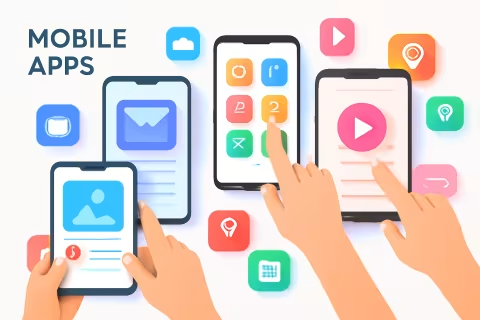Mobile Apps:
Mobile apps, or mobile applications, are specially designed software programs that run on smartphones, tablets, and other handheld devices. They have revolutionised the way we interact with technology, making information, services, and entertainment accessible anytime, anywhere. Whether for business, productivity, social connection, health, or personal enjoyment, mobile apps have become an indispensable part of daily life.
Key Features of Mobile Apps
- User-Focused Design: Mobile apps are crafted with the end-user in mind, prioritising intuitive navigation, responsive layouts, and engaging interfaces suited for touchscreens of various sizes.
- Accessibility: Designed to work seamlessly on iOS and Android platforms, as well as across diverse device types, ensuring a smooth experience no matter what hardware is used.
- Performance: Mobile apps are optimised for speed, efficiency, and low resource consumption, delivering fast loading times and reliable performance even on slower networks.
- Personalisation: Many apps offer customizable settings, recommendations, and user profiles, adapting to individual preferences and usage patterns for a tailored experience.
- Offline Capabilities: Unlike web apps, many mobile apps can offer partial or full functionality without an active internet connection, improving reliability and usability.
- Integration: Apps often leverage device capabilities like GPS, camera, microphone, contacts, push notifications, and sensors, enhancing their functionality and enabling richer interactions.
Types of Mobile Apps
- Native Apps: Built specifically for one platform (iOS or Android) using platform-specific programming languages (Swift for iOS, Kotlin/Java for Android). They tend to deliver the best performance and utilise device features fully.
- Hybrid Apps: Developed using web technologies (HTML, CSS, JavaScript) and wrapped in a native container. They run on multiple platforms with a single codebase, optimising development costs and time.
- Progressive Web Apps (PWAs): Web-based applications that provide an app-like experience through a web browser, supporting offline use and push notifications without an app store download.
The Mobile App Development Process
- Idea & Strategy: Defining app objectives, target audience, and key features based on business goals and user research.
- Design: Creating wireframes and prototypes, focusing on UI/UX design to ensure intuitive interaction and appealing visuals.
- Development: Coding the app for the chosen platforms, integrating backend services and APIs, and enabling necessary device features.
- Testing: Running tests for usability, security, performance, and compatibility across devices to resolve bugs and ensure stability.
- Deployment: Publishing the app on app stores (Google Play, Apple App Store) and making it available for users to download.
- Ongoing Maintenance: Updating the app for new features, security patches, operating system updates, and responding to user feedback.
Benefits of Mobile Apps
- Convenience: Always within reach, mobile apps enable instant access to tools, content, and services.
- Engagement: Features like push notifications, in-app messaging, and rewards programs keep users informed and involved.
- Business Growth: Apps can drive brand visibility, loyalty, and conversions, enabling companies to reach and serve customers more effectively.
- Innovation: Mobile apps are platforms for new technologies such as AR/VR, AI, and IoT - enabling creative and functional possibilities.
Conclusion
Mobile apps are central to our connected world. By combining effective design, technological innovation, and a relentless focus on user needs, mobile apps empower individuals and businesses alike. They enhance daily life, streamline operations, and create new opportunities for interaction, making them an essential component of modern digital strategy.
Category
Pictures
- Image

